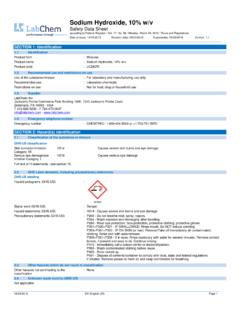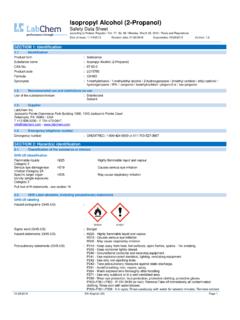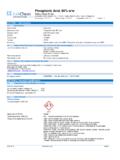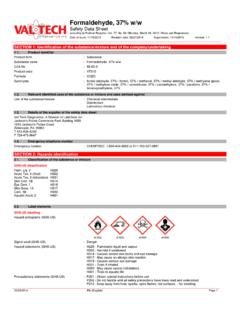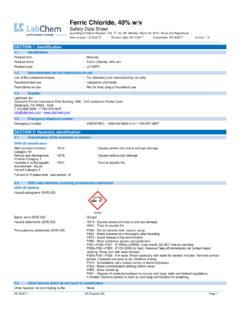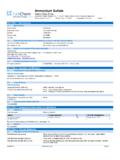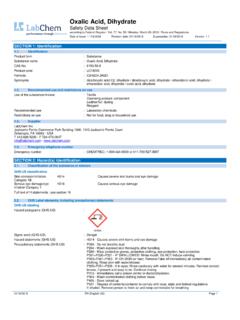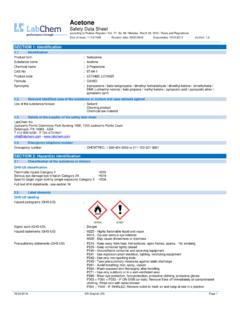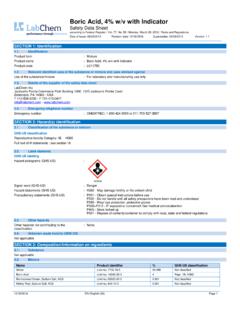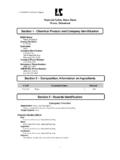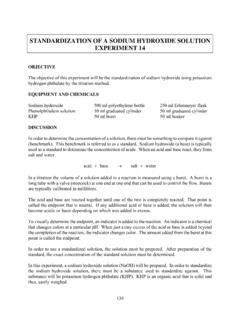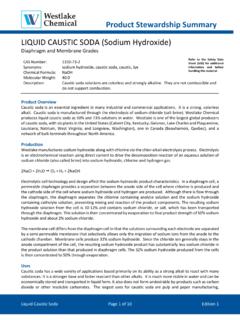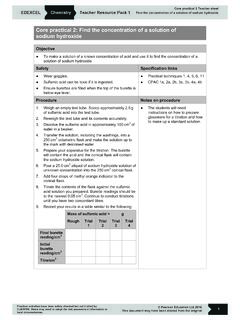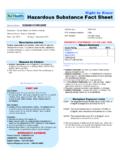Transcription of Sodium Hydroxide - labchem.com
1 Sodium Hydroxide Safety Data Sheet according to Federal Register / Vol. 77, No. 58 / Monday, March 26, 2012 / Rules and Regulations Date of issue: 07/06/1998 Revision date: 02/21/2018 Supersedes: 10/14/2013 Version: 02/21/2018 EN (English) Page 1 SECTION 1: Identification Identification Product form : Substance Substance name : Sodium Hydroxide CAS-No. : 1310-73-2 Product code : LC23900 Formula : NaOH Synonyms : anhydrous caustic soda / caustic alkali / caustic flake / caustic soda, solid / caustic white / caustic, flaked / hydrate of soda / Hydroxide of soda / LEWIS red devil lye / soda lye / Sodium hydrate / Sodium Hydroxide , pellets Recommended use and restrictions on use Use of the substance/mixture : Industrial use Recommended use : Laboratory chemicals Restrictions on use : Not for food, drug or household use Supplier LabChem Inc Jackson's Pointe Commerce Park Building 1000, 1010 Jackson's Pointe Court Zelienople, PA 16063 - USA T 412-826-5230 - F 724-473-0647 - Emergency telephone number Emergency number : CHEMTREC: 1-800-424-9300 or 011-703-527-3887 SECTION 2.
2 Hazard(s) identification Classification of the substance or mixture GHS-US classification Skin corrosion/irritation, Category 1A H314 Causes severe skin burns and eye damage. Serious eye damage/eye irritation, Category 1 H318 Causes serious eye damage. Hazardous to the aquatic environment Acute Hazard, Category 3 H402 Harmful to aquatic life Full text of H statements : see section 16 GHS Label elements, including precautionary statements GHS-US labelling Hazard pictograms (GHS-US) : GHS05 Signal word (GHS-US) : Danger Hazard statements (GHS-US) : H314 - Causes severe skin burns and eye damage. H402 - Harmful to aquatic life Precautionary statements (GHS-US) : P260 - Do not breathe dust, vapours. P264 - Wash exposed skin thoroughly after handling. P273 - Avoid release to the environment. P280 - Wear eye protection, face protection, protective clothing, protective gloves.
3 P301+P330+P331 - IF SWALLOWED: rinse mouth. Do NOT induce vomiting. P303+P361+P353 - IF ON SKIN (or hair): Take off immediately all contaminated clothing. Rinse skin with water/shower. P304+P340 - IF INHALED: Remove person to fresh air and keep comfortable for breathing. P305+P351+P338 - IF IN EYES: Rinse cautiously with water for several minutes. Remove contact lenses, if present and easy to do. Continue rinsing. P310 - Immediately call a POISON CENTER/doctor Sodium Hydroxide Safety Data Sheet according to Federal Register / Vol. 77, No. 58 / Monday, March 26, 2012 / Rules and Regulations 02/21/2018 EN (English) 2/9 P363 - Wash contaminated clothing before reuse. P405 - Store locked up. P501 - Dispose of contents/container to Comply with applicable regulations Other hazards which do not result in classification Other hazards not contributing to the classification : None under normal conditions.
4 Unknown acute toxicity (GHS US) Not applicable SECTION 3: Composition/information on ingredients Substances Substance type : Mono-constituent Name Product identifier % GHS-US classification Sodium Hydroxide (Main constituent) (CAS-No.) 1310-73-2 100 Skin Corr. 1A, H314 Eye Dam. 1, H318 Aquatic Acute 3, H402 Full text of hazard classes and H-statements : see section 16 Mixtures Not applicable SECTION 4: First-aid measures Description of first aid measures First-aid measures general : Check the vital functions. Unconscious: maintain adequate airway and respiration. Respiratory arrest: artificial respiration or oxygen. Cardiac arrest: perform resuscitation. Victim conscious with laboured breathing: half-seated. Victim in shock: on his back with legs slightly raised. Vomiting: prevent asphyxia/aspiration pneumonia. Prevent cooling by covering the victim (no warming up).
5 Keep watching the victim. Give psychological aid. Keep the victim calm, avoid physical strain. Depending on the victim's condition: doctor/hospital. First-aid measures after inhalation : Remove the victim into fresh air. Respiratory problems: consult a doctor/medical service. First-aid measures after skin contact : Wipe off dry product from skin. Remove clothing before washing. Wash immediately with lots of water (15 minutes)/shower. Do not apply (chemical) neutralizing agents. Do not remove clothing if it sticks to the skin. Cover wounds with sterile bandage. Consult a doctor/medical service. If burned surface > 10%: take victim to hospital. First-aid measures after eye contact : Rinse immediately with plenty of water for 15 minutes. Remove contact lenses, if present and easy to do. Continue rinsing. Do not apply neutralizing agents. Take victim to an ophthalmologist.
6 First-aid measures after ingestion : Rinse mouth with water. Immediately after ingestion: give lots of water to drink. Do not induce vomiting. Do not give activated charcoal. Do not give chemical antidote. Immediately consult a doctor/medical service. Call Poison Information Centre ( ). Ingestion of large quantities: immediately to hospital. Take the container/vomit to the doctor/hospital. Most important symptoms and effects (acute and delayed) Symptoms/effects after inhalation : WHEN PROCESSED: Dry/sore throat. Coughing. Irritation of the respiratory tract. Irritation of the nasal mucous membranes. ON CONTINUOUS EXPOSURE/CONTACT: Respiratory difficulties. FOLLOWING SYMPTOMS MAY APPEAR LATER: Possible oedema of the upper respiratory tract. Possible laryngeal spasm/oedema. Risk of lung oedema. Symptoms/effects after skin contact : Blisters. Caustic burns/corrosion of the skin.
7 Slow-healing wounds. Symptoms/effects after eye contact : Corrosion of the eye tissue. Permanent eye damage. Symptoms/effects after ingestion : Dry/sore throat. Nausea. Abdominal pain. Blood in vomit. Difficulty in swallowing. Possible esophageal perforation. Burns to the gastric/intestinal mucosa. Bleeding of the gastrointestinal tract. Shock. Chronic symptoms : ON CONTINUOUS/REPEATED EXPOSURE/CONTACT: Dry skin. Skin rash/inflammation. Possible inflammation of the respiratory tract. Gastrointestinal complaints. Immediate medical attention and special treatment, if necessary Obtain medical assistance. SECTION 5: Fire-fighting measures Suitable (and unsuitable) extinguishing media Suitable extinguishing media : Adapt extinguishing media to the environment for surrounding fires. Sodium Hydroxide Safety Data Sheet according to Federal Register / Vol. 77, No.
8 58 / Monday, March 26, 2012 / Rules and Regulations 02/21/2018 EN (English) 3/9 Specific hazards arising from the chemical Fire hazard : DIRECT FIRE HAZARD: Non combustible. INDIRECT FIRE HAZARD: Reactions involving a fire hazard: see "Reactivity Hazard". Explosion hazard : INDIRECT EXPLOSION HAZARD: Reactions with explosion hazards: see "Reactivity Hazard". Reactivity : May be corrosive to metals. Absorbs the atmospheric CO2. Violent to explosive reaction with (some) acids. Reacts violently with many compounds: heat release resulting in increased fire or explosion risk. Violent exothermic reaction with water (moisture): release of corrosive mist. Reacts exothermically on exposure to water (moisture) with combustible materials: risk of spontaneous ignition. Special protective equipment and precautions for fire-fighters Precautionary measures fire : Exposure to fire/heat: keep upwind.
9 Exposure to fire/heat: consider evacuation. Exposure to fire/heat: have neighbourhood close doors and windows. Firefighting instructions : Cool tanks/drums with water spray/remove them into safety. When cooling/extinguishing: no water in the substance. Take account of toxic fire-fighting water. Use water moderately and if possible collect or contain it. Protection during firefighting : Heat/fire exposure: compressed air/oxygen apparatus. SECTION 6: Accidental release measures Personal precautions, protective equipment and emergency procedures General measures : Absorb spillage to prevent material damage. Dike and contain spill. For non-emergency personnel Protective equipment : Gloves. Face-shield. Corrosion-proof suit. Dust cloud production: compressed air/oxygen apparatus. Contact with moisture/water: compressed air/oxygen apparatus. Contact with moisture/water: gas-tight suit.
10 Emergency procedures : Mark the danger area. Prevent dust cloud formation. Corrosion-proof appliances. Keep containers closed. Avoid ingress of water in the containers. Wash contaminated clothes. On contact with moisture/water: keep upwind. On contact with moisture/water: consider evacuation. In case of hazardous reactions: keep upwind. In case of reactivity hazard: consider evacuation. Measures in case of dust release : In case of dust production: keep upwind. Dust production: have neighbourhood close doors and windows. For emergency responders Protective equipment : Equip cleanup crew with proper protection. Do not breathe dust. Emergency procedures : Stop release. Environmental precautions Prevent soil and water pollution. Prevent spreading in sewers. Methods and material for containment and cleaning up For containment : Contain released product, pump into suitable containers.
